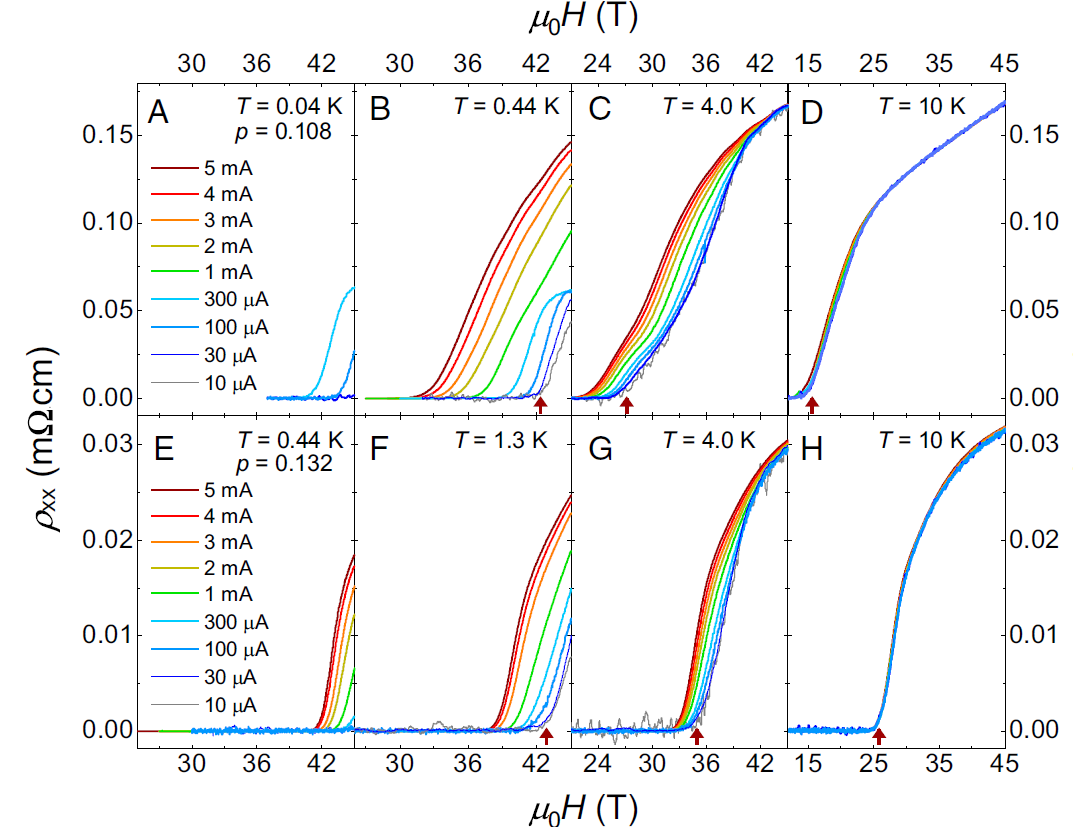
In-plane electrical resistivity rxx of YBa2Cu3O6+x at different temperatures T, hole dopings p, and currents I.
Background
A central question in the underdoped cuprates pertains to the nature of the pseudogap ground state. Previous electrical transport measurements in underdoped YBa2Cu3O6+x reported the occurrence of quantum oscillations above modest magnetic fields ~22 T in a conventional metallic pseudogap ground state characterized by finite electrical resistivity, in which superconductivity is destroyed.
What we discover?
We use low applied measurement currents and millikelvin temperatures on ultrapure single crystals of underdoped YBa2Cu3O6+x to unearth an unconventional quantum vortex matter ground state characterized by vanishing electrical resistivity, magnetic hysteresis, and nonohmic electrical transport characteristics. A model of the pseudogap ground state is now required to explain quantum oscillations that are hosted by the bulk quantum vortex matter state without experiencing sizable additional damping in the presence of a large maximum superconducting gap; possibilities include a pair density wave.
Why is this important?
Modest magnetic fields above ~22 T in the underdoped cuprates were argued to destroy superconductivity and reveal a conventional metallic pseudogap ground state that hosts quantum oscillations. We perform high-magnetic field electrical resistivity and magnetic torque measurements using low temperatures and small applied measurement currents to reveal instead an unconventional quantum vortex matter ground state that persists beyond the highest static magnetic fields. An alternative model is required to explain the coexistence of quantum oscillations with a robust d-wave superconducting gap in the newly uncovered quantum vortex matter ground state.
Why did we need WHMFC?
In this study, Professor Suchitra E. Sebastian's team measured the temperature and magnetic field dependent resistance, which is provided experimental evidence for the discovery of the quantum vortex matter ground state.
Who did the research?
1. Cavendish Laboratory, Cambridge University, Cambridge CB3 0HE, United Kingdom
Yu-Te Hsu, Mate Hartstein, Alexander J. Davies, Alexander J. Hickey, Sofia V. Taylor, Hsu Liu, Alexander G. Eaton, Gilbert G. Lonzarich, Suchitra E. Sebastian.
2. Pulsed Field Facility, Los Alamos National Laboratory, Los Alamos, NM 87545
Mun K. Chan, Neil Harrison.
3. Department of Solid State Spectroscopy, Max Planck Institute for Solid State Research, D-70569 Stuttgart, Germany
Juan Porras, Toshinao Loew, Matthieu Le Tacon, Bernhard Keimer
4. Institute for Quantum Materials and Technology, Karlsruhe Institute of Technology, 1D-76344 Eggenstein-Leopoldshafen, Germany
Matthieu Le Tacon
5. Wuhan National High Magnetic Field Center and School of Physics, Huazhong University of Science and Technology, 430074 Wuhan, China
Huakun Zuo, Jinhua Wang, Zengwei Zhu
Acknowledgments
Y.-T.H., M.H., A.J.D., A.J.H., S.V.T., H.L., and S.E.S. acknowledge support from the Royal Society; the Winton Program for the Physics of Sustainability; an Engineering and Physical Sciences Research Council (EPSRC) studentship; EPSRC Grants EP/R513180/1, EP/M506485/1, and EP/P024947/1; and the European Research Council under the European Union’s Seventh Framework Program Grants 337425 and 772891. H.Z., J.W., and Z.Z. acknowledge support from National Key Research and Development Program of China Grant 2016YFA0401704. S.E.S. acknowledges support from the Leverhulme Trust by way of the award of a Philip Leverhulme Prize. Some of magnetic measurements were carried out using the Advanced Materials Characterization Suite in the University of Cambridge, funded by EPSRC Strategic Equipment Grant EP/M000524/1. A portion of this work was performed at the National High Magnetic Field Laboratory, which is supported by NSF Cooperative Agreement DMR- 1157490, the State of Florida, and the Department of Energy. M.K.C. and N.H. acknowledge support from the Department of Energy BES project: “Science of 100 tesla.” We thank S. A. Kivelson for suggesting the application of the vortex model of Huse et al. to our data. We are grateful for helpful discussions with colleagues including P. W. Anderson, L. Benfatto, J. Blatter, J. C. S. Davis, N. Doiron-Leyraud, M. Eisterer, E. M. Forgan, R. H. Friend, D. Geshkenbein, P. Kim, S. A. Kivelson, M. H. Julien, D. H. Lee, P. A. Lee, T. Maniv, D. R. Nelson, M. R. Norman, N. P. Ong, C. Pepin, M. Randeria, S. Sachdev, J. Schmalian, T. Senthil, L. Taillefer, C. M. Varma, and H. H. Wen. We are also grateful for experimental support at National High Magnetic Field Laboratory Tallahassee from J. Billings, E. S. Choi, B. L. Dalton, D. Freeman, L. J. Gordon, D. E. Graf, M. Hicks, S. A. Maier, T. P. Murphy, J.-H. Park, K. N. Piotrowski, and others. We thank S. Lacher and C. T. Lin for assistance with synthesis of high-quality single crystals.
Link
https://www.pnas.org/content/118/7/e2021216118
